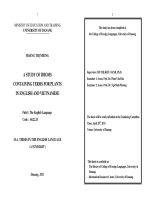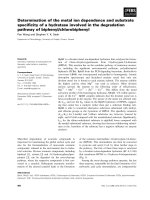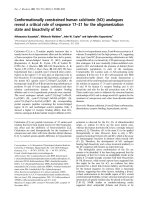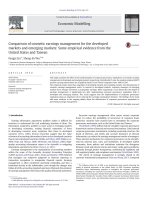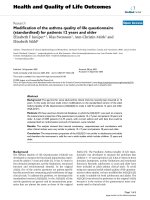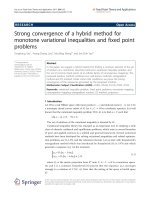Engineering of oligopeptide modified surface for metal ion adsorption and sensing applications
Bạn đang xem bản rút gọn của tài liệu. Xem và tải ngay bản đầy đủ của tài liệu tại đây (3.59 MB, 264 trang )
ENGINEERING OF OLIGOPEPTIDE-MODIFIED SURFACE
FOR METAL ION ADSORPTION AND SENSING
APPLICATIONS
BI XINYAN
NATIONAL UNIVERSITY OF SINGAPORE
2009
ENGINEERING OF OLIGOPEPTIDE-MODIFIED SURFACE
FOR METAL ION ADSORPTION AND SENSING
APPLICATIONS
BI XINYAN
(M. Eng.)
A THESIS SUBMITTED
FOR THE DEGREE OF DOCTOR OF PHILOSOPHY
DEPARTMENT OF CHEMICAL AND BIOMOLECULAR
ENGINEERING
NATIONAL UNIVERSITY OF SINGAPORE
Acknowledgements
i
ACKNOWLEDGEMENTS
First of all, I would like to thank my parents and my husband for their infinite love
and support. They have been the source of courage when I was down and the reason
why I cannot give up.
I am especially grateful to my supervisor, Dr. Kun-Lin Yang, for his guidance,
patience, continuous encouragement, invaluable suggestions, and considerable
understanding throughout the period of this project. In addition to giving me the
interesting and challenging research projects, he gave me freedom to express my ideas
and instructed me how to write scientific papers and PhD thesis. His enthusiasm,
sincerity, and dedication on scientific research have greatly impressed me and will
benefit me in my future career.
I would also like to thank Dr. Ajay Agarwal and the members of Institute of
Microelectronics (A*STAR) for their strong supports in silicon nanowire experiments.
The research scholarship funded by NUS is also gratefully acknowledged.
I want to give many thanks to all people in our group: Deny, Siok Lian, Laura, Vera,
Xu Huan, Yadong, Maricar, Chih Hsin, Zhang Wei, and Xiaokang (in the order that I
got to know them). I not only obtained lots of their help but also shared fun and joy
with them.
I would like to take this opportunity to acknowledge Prof. Chen Shing Bor and Dr.
Yung Lin-Yue Lanry, the members of my oral qualification examination committee,
for their inspired suggestions and comments on this topic, together with my thesis
Acknowledgements
ii
reviewers for their time, assistance and examination on this thesis.
Acknowledgement also goes to Mr. Boey, Ms. Lee Chai Keng, Dr. Yuan Zeliang, Dr.
Rajarathnam D., Ms. Chew Su Mei Novel, Ms. Goh Mei Ling Evelyn for their kind
supports in my experiments.
Finally, I would like to thank Chinese government for giving me the award for
outstanding self-financed students abroad in 2008. I would also like to appreciate the
people who have contributed either directly or indirectly to this thesis work but have
not been mentioned above.
Table of content
iii
TABLE OF CONTENT
ACKNOWLEDGEMENTS
i
TABLE OF CONTENT
iii
SUMMARY
vi
LIST OF TABLES
viii
LIST OF FIGURES
ix
LIST OF SCHEMES
xx
LIST OF SYMBOLS
xxii
Chapter 1. Introduction
1
1.1 Adsorption of metal ions 1
1.2 Metal ion sensors 3
1.3 Oligopeptides immobilization
5
1.4 Biosensors for monitoring enzymatic activities
6
1.5 Research objectives
9
Chapter 2. Literature review
13
2.1 Interactions between metal ions and oligopeptides 13
2.1.1 Formation of oligopeptide-metal complex in solution 13
2.1.2
Formation of oligopeptide-metal complex on solid surfaces 16
2.1.3 Molecular imprinting
18
2.2 Immobilization of oligopeptides on surfaces
21
2.2.1 Reaction between primary amine and surface aldehyde
22
2.2.2 Reaction between primary amine and surface carboxylate
23
2.2.3 Immobilization of oligopeptides through single anchoring
point
24
2.3 Silicon nanowire-based sensors
26
2.3.1 Semiconductor physics
27
2.3.2 Fabrication of SiNWs-based FETs
28
2.3.3 Sensing applications
30
2.4 Liquid crystals (LCs)
36
2.4.1 Definition of LCs
36
2.4.2 Anchoring of LC on solid surfaces
38
2.4.3 Optical properties of LC
39
2.4.4 LCs-based sensors
41
Chapter 3. Oligoglycines-modified surfaces for Cu
2+
adsorption
47
3.1 Ion-imprinted silica gels functionalized with oligoglycines for
Cu
2+
adsorption
47
3.1.1 Introduction
47
3.1.2 Experimental section
50
3.1.3 Results and discussion
53
Table of content
iv
3.1.4 Conclusions
75
3.2 Interactions between ion-imprinted silica surfaces with Cu
2+
76
3.2.1 Introduction
76
3.2.2 Experimental section
79
3.2.3 Results and discussion
82
3.2.4 Conclusions
96
Chapter 4. Complexation of Cu
2+
with histidine-containing tripeptides
97
4.1 Introduction
97
4.2 Experimental section
100
4.3 Results and discussion
102
4.4 Conclusions
115
Chapter 5. Development of silicon nanowire based Cu
2+
sensors
117
5.1 Introduction
117
5.2 Experimental section
118
5.3 Results and discussion
120
5.4 Conclusions
126
Chapter 6. Silicon nanowire arrays as multichannel metal ion sensors
127
6.1 Introduction
127
6.2 Experimental section
128
6.3 Results and discussion
130
6.4 Conclusions
136
Chapter 7. Controlling orientations of immobilized oligopeptides using
N-terminal cysteine labels
137
7.1 Introduction
137
7.2 Experimental section
138
7.3 Results and discussion
141
7.4 Conclusions
151
Chapter 8. Detecting oligoglycines by using liquid crystals
152
8.1 Introduction
152
8.2 Experimental section
156
8.3 Results and discussion
158
8.4 Conclusions
168
Chapter 9. Liquid crystal multiplexed protease assays
170
9.1 Introduction
170
9.2 Experimental section
173
9.3 Results and discussion
177
9.4 Conclusions
189
Table of content
v
Chapter 10. Liquid crystal pH sensor for monitoring enzymatic activities
191
10.1 Introduction
191
10.2 Experimental section
193
10.3 Results and discussion
195
10.4 Conclusions
208
Chapter 11. Conclusions and recommendations
210
11.1 Conclusions
210
11.2 Recommendations
214
References
218
List of publications
239
Summary
vi
SUMMARY
Surfaces presenting unique functionalities have found tremendous applications, such
as separation and sensor design. Unlike traditional self-assembled monolayers (SAMs)
offering limited choices, the surfaces modified with custom-made oligopeptides are
versatile, because the sequences of oligopeptides can be tailored for binding metal
ions and biomolecules with high specificity. First, past studies have demonstrated that
oligopeptides with particular side groups are able to complex metal ions with high
sensitivity and selectivity, hence, silica gel modified with Gly-Gly-Gly or
Gly-Gly-His can adsorb Cu
2+
with high selectivity, even in the presence of Zn
2+
. This
principle was also applied to modify silicon nanowire (SiNW) to create a sensitive
Cu
2+
sensor. Secondly, it is known that to fabricate metal ion sensors, the
oligopeptides with specific sequences need to be immobilized on the surface with a
well-defined orientation to keep their functions. In this thesis, we demonstrated that
an N-terminal cysteine label lead to well-oriented immobilized oligopeptides. Thus,
SiNWs modified with a Pb
2+
-sensitive oligopeptide can be used to detect Pb
2+
in the
presence of Cu
2+
. Finally, we exploited interactions between liquid crystals (LCs) and
immobilized oligopeptide for creating real-time enzyme biosensors. The detection
principle is based on the changes of the anchoring of LCs supported on surfaces,
because the anchoring of LCs can be easily affected by the chemical compositions and
molecular-level structures of surfaces. Our results show that the enzymatic cleavages
of oligopeptide substrates can lead to changes in the optical appearance of LCs.
Summary
vii
Moreover, because anchoring of LCs is controlled by a fine scale of energetics, it is
possible to couple the orientations of LCs to surfactants, lipids, proteins, and synthetic
polymers adsorbed at the aqueous/LC interface. Based on this principle, we sought to
design a new LC based pH sensor and study the feasibility of using the LC based pH
sensor for monitoring H
+
released from enzymatic reactions in real time. These new
principles may offer tremendous opportunities for developing next-generation
biosensors.
List of tables
viii
LIST OF TABLES
Table 3.1
(p56)
Elemental analysis data showing the weight percentage of chemical
composition (C, H, N) of silica gel after each chemical modification
step.
Table 9.1
(p175)
Sequences of P1 ~ P6 and their cleavage sites for trypsin and
chymotrypsin, respectively.
List of figures
ix
LIST OF FIGURES
Figure 2.1
(p14)
Complexation of metal ions to diglycine.
Figure 2.2
(p15)
Structures of major copper complexes with Gly-Gly-His in aqueous
solutions.
Figure 2.3
(p17)
Schematic illustrations of the Gly-Gly-His-modified electrode with
and without complexed Cu
2+
.
Figure 2.4
(p21)
Schematic illustrations of copper-selective surface binding sites
created by using 2D molecular imprinting techniques.
Figure 2.5
(p23)
Schematic illustration of a glass slide surface modified with an
aldehyde-containing organosilane TEA and the reaction of glycine
oligomers with aldehyde groups through the formation of Schiff
base, which was further reduced to a stable secondary amine by a
reducing agent NaBH
3
CN.
Figure 2.6
(p24)
The reaction between primary amine and carboxylic acid via the
carbodiimide coupling agent.
Figure 2.7
(p25)
Schematic illustrations showing the immobilization of TEA and
oligopeptides on the surfaces through (a) multiple anchoring points
and (b) single anchoring point.
Figure 2.8
(p30)
Schematic illustration of a SiNW FET showing metal source and
drain electrodes with the NW and contacts on the surface of SiO
2
substrate.
Figure 2.9
(p32)
(a) APTES-modified SiNW surface changes surface charges with
pH. (b) Plot of the conductance versus pH (Cui et al., 2001a).
Figure 2.10
(p33)
Real-time detection of protein binding. (a) Schematic illustrating a
biotin-modified SiNW (left) and subsequent binding of streptavidin
to the SiNW surface (right). (b) Plot of conductance versus time for a
biotin-modified SiNW. (c) Conductance versus time for an un-
modified SiNW. (d) Conductance versus time for a biotin-modified
SiNW. (e) Conductance versus time for a biotin-modified SiNW (Cui
et al., 2001a).
List of figures
x
Figure 2.11
(p37)
Molecular structures of 5CB and MBBA.
Figure 2.12
(p38)
Structure of the nematic phase aligned in a single direction.
Figure 2.13
(p39)
(a) Alignment of 5CB supported on DMOAP-modified glass slides.
(b) Homeotropic orientation of 5CB supported on DMOAP-modified
glass slides. (c) Molecular structure of DMOAP.
Figure 2.14
(p40)
The effect of polarizing filters on the LC cells inserted with (a)
isotropic material; (b) nematic LCs with the director not oriented
parallel to the polarizer or analyzer. The polarizer allows only light
polarized along the x-axis to pass, while the analyzer allows only
light polarized along the y-axis to pass.
Figure 2.15
(p43)
Schematic illustration of surface topography with and without
protein bound to a SAM supported on a surface possessing
nanometer scale topography (Gupta et al. 1998).
Figure 2.16
(p44)
Schematic illustrations of orientations of LCs supported on a surface
modified with molecular receptors (a) before and (b) after exposing
to the targeted vapor analytes.
Figure 2.17
(p45)
Anchoring of 5CB by aqueous solutions of SDS. Optical images
(crossed polars) of 5CB hosted in a copper grid supported on an
OTS-coated glass slide and placed into contact with (a) water or (b) a
2.2 mM aqueous solution of SDS (Brake et al., 2002).
Figure 3.1
(p54)
(a) Absorbance (at 506 nm) of various aqueous solutions containing
0.1 mM of dithizone, 4% of Triton X-100, and different
concentration of copper (0 – 350 µg/mL). The fitting line was used
as a calibration curve for the determination of copper concentration.
(b) Comparison of copper concentrations obtained from UV-vis
spectroscopy and the standard concentration at different pH.
Figure 3.2
(p65)
Effect of pH on the percentage of copper adsorption by using
copper-imprinted and nonimprinted silica gels functionalized with
(a) glycine (b) diglycine and (c) triglycine. The concentration of
copper was 4.0 µg/mL.
Figure 3.3
(p67)
Amounts of copper adsorbed per unit mass of copper-imprinted and
nonimprinted silica gels functionalized with (a) glycine, (b)
diglycine and (c) triglycine as a function of copper concentration at
pH = 4.5.
List of figures
xi
Figure 3.4
(p68)
Comparison of total copper adsorption capacities of copper-
imprinted and nonimprinted silica gels at pH = 4.5. The silica gels
were functionalized with glycine, diglycine and triglycine,
respectively.
Figure 3.5
(p70)
Percentage of copper adsorption by using copper-imprinted and
nonimprinted silica gels functionalized with (a) glycine (b) diglycine
and (c) triglycine at different pH. In all of the adsorption
experiments, magnesium (II) was added to the copper solution as a
competing metal ion. The concentration of copper and magnesium
were 4.0 µg/mL and 200 µg/mL, respectively.
Figure 3.6
(p71)
Percentage of copper adsorption by using copper-imprinted and
nonimprinted silica gels functionalized with (a) glycine (b) diglycine
and (c) triglycine at different pH. In all of the adsorption
experiments, calcium (II) was added to the copper solution as a
competing metal ion. The concentration of copper and calcium were
4.7 µg/mL and 360 µg/mL respectively.
Figure 3.7
(p72)
Percentage of copper desorption from the copper-imprinted and
nonimprinted silica gels functionalized with glycine, diglycine, and
triglycine. The copper-loaded silica gel was incubated in 1.0 M of
HCl for 30 min to desorb the copper ions.
Figure 3.8
(p74)
Multiple use cycles of copper-imprinted and nonimprinted silica gels
functionalized with (a) glycine, (b) diglycine and (c) triglycine.
Figure 3.9
(p83)
HATR-FTIR spectra of MES buffer (10 mM, pH = 6) containing 1
mM of triglycine and different concentrations of copper ions.
Cu-free triglycine solution was used as a reference.
Figure 3.10
(p84)
HATR-FTIR spectra of an aldehyde-decorated silicon trough plate
with triglycine immobilized on the surface. The aldehyde-decorated
surface was used as a reference.
Figure 3.11
(p86)
(a) XPS spectra (Cu2p) and (b) HATR-FTIR spectra of 1 after it was
immersed in different concentrations of copper solutions at pH 6 and
blown dry with nitrogen. The spectrum of 1 before exposing to
copper solutions was used as a reference in (b).
Figure 3.12
(p88)
HATR-FTIR spectra for 3 and 4. Surface 4 was obtained by
immersion of 3 into 1 M HNO
3
for 5 min to remove copper ions. The
spectrum of the aldehyde-decorated silicon trough plate was used as
a reference.
List of figures
xii
Figure 3.13
(p89)
(a) XPS spectra (Cu2p) of 4 after it was immersed in different
concentrations of copper solutions at pH 6 and blown dry with
nitrogen. (b) XPS peak areas of Cu2p for 1 and 4, after they were
immersed in the copper solutions with various concentrations. The
peak areas were calculated from Figure 3.18A and 4.20A.
Figure 3.14
(p90)
HATR-FTIR spectra of 4 after it was immersed in different
concentrations of copper solutions at pH 6 and blown dry with
nitrogen. The spectrum of 4 before exposing to copper solutions was
used as a reference.
Figure 3.15
(p91)
XPS Cu2p peak areas showing the amounts of copper ions adsorbed
on four different surfaces with different ratios of tetraglycine/glycine
immobilized on the surfaces. These surfaces were incubated in 10
M of copper solutions (pH = 6), rinsed with ethanol and blown dry
before spectra were taken.
Figure 3.16
(p93)
XPS spectra of 4, after it was immersed in a solution containing 10
M copper and 1 mM zinc and rinsed with ethanol, (a) Cu2p and (b)
Zn2p.
Figure 3.17
(p94)
XPS spectra of 1, after it was immersed in a solution containing 10
M copper and 1 mM zinc and rinsed with ethanol, (a) Cu2p and (b)
Zn2p.
Figure 3.18
(p95)
XPS spectra of 4, after it was immersed in a solution containing 10
M copper and 1 mM nickel and rinsed with ethanol, (a) Cu2p and
(b) Ni2p.
Figure 4.1
(p103)
Titrating 0.3 mM of (a) His-Gly-Gly, and (b) Gly-Gly-His in MES
buffer (pH = 6.0) with copper nitrate solutions. The number indicates
the final copper concentrations in the solution.
Figure 4.2
(p105)
Effect of (a) buffer concentration and (b) reaction time on the
immobilization of 1 mM of Gly-Gly-His or His-Gly-Gly on
aldehyde-decorated silicon wafer. The results show that the
ellipsometric thickness increases with the buffer concentration and
the reaction time.
Figure 4.3
(p107)
XPS spectra (N1s) for (a) TEA, (b) His-Gly-Gly, and (c)
Gly-Gly-His functionalized silicon wafers.
List of figures
xiii
Figure 4.4
(p108)
XPS spectra (Cu2p) for (a) His-Gly-Gly and (b) Gly-Gly-His
functionalized silicon wafers, after they were immersed in copper
nitrate solutions with various concentrations and cleaned with
ethanol.
Figure 4.5
(p109)
XPS Peak areas of Cu2p
3/2
for silicon wafers functionalized with
Gly-Gly-His or His-Gly-Gly. The peak areas were calculated by
using Figure 4.4.
Figure 4.6
(p111)
(a) Ellipsometric thicknesses of the thin organic layers on GGH-2h,
GGH-1h, and Imprinted GGH. (b) XPS spectra (N1s) for
GGH-2h, GGH-1h, and Imprinted GGH. The measurements were
taken after the silicon wafers were immersed in a 10M copper
nitrate solution and cleaned with ethanol.
Figure 4.7
(p113)
(a) XPS spectra (Cu2p) and (b) Cu2p
3/2
peak area for GGH-2h,
GGH-1h, and Imprinted GGH. The measurements were taken after
the silicon wafers were immersed in a 10 µM copper nitrate solution
and cleaned with ethanol. The dotted line is Imprinted GGH before
its immersion into the copper nitrate solution. It shows that no
copper ions left on the surface after the ion-imprinting procedure.
Figure 5.1
(p123)
Effect of (a) copper ion concentration and (b) zinc ion concentration
on the conductance change of two tripeptides-modified SiNWs and
aldehyde-terminated SiNWs (control experiment). The conductance
increased almost linearly with the logarithm of the metal ion
concentration for both Gly-Gly-His- and Gly-His-Gly-modified
SiNWs, which can be attributed to metal ion binding on the
tripeptides-modified surfaces. All solutions were prepared in MES
buffer (100 mM, pH = 6).
Figure 5.2
(p125)
(a) Changes in the conductance of Gly-Gly-His-modified SiNWs
immersed in solutions containing different concentrations of copper
ions (from 1 nM to 10 mM) or mixed solutions containing both
copper and zinc ions. The zinc ion concentration was 100 times
higher than the copper ion concentration. (b) Kinetic behavior of the
conductance of a Gly-Gly-His-modified SiNW exposed to MES
buffer and copper solutions, alternatively.
Figure 6.1
(p130)
Typical I -V curves for 5 different SiNWs in one cluster.
Figure 6.2
(p131)
(a) Optical image of three SiNW clusters (each cluster has 5 SiNWs).
Zoom-in SEM image showing 5 SiNWs in one cluster. (b) Schematic
illustration of the surface modification of aldehyde-terminated SiNW
List of figures
xiv
clusters (cluster0) with oligopeptides specific for Pb
2+
(Cys-Asp-Arg-Val-Tyr-Ile-His-Pro-Phe-His-Leu, cluster1) and Cu
2+
(Gly-Gly-His, cluster2), respectively.
Figure 6.3
(p132)
SEM-EDX spectroscopy of SiNWs modified with (a)
Cys-Asp-Arg-Val-Tyr-Ile-His-Pro-Phe-His-Leu and (b) Gly-Gly-His,
respectively, after they were immersed into a mixed solution
containing 100 nM Pb
2+
and 100 nM Cu
2+
. Inset shows the SEM
image.
Figure 6.4
(p133)
Conductance versus time data recorded simultaneously in three
different SiNW clusters. The surfaces of these clusters were modified
with (a) Cys-Asp-Arg-Val-Tyr-Ile-His-Pro-Phe-His-Leu, (b)
Gly-Gly-His, and (c) aldehyde, respectively. The arrows indicate the
sequential introduction of 1 nM Pb
2+
, MES, 10 nM Pb
2+
, MES, and
then 10 nM Cu
2+
on the SiNW clusters.
Figure 6.5
(p136)
Effects of Pb
2+
concentration on the conductance of SiNWs
(modified with Cys-Asp-Arg-Val-Tyr-Ile-His-Pro-Phe-His-Leu)
under two conditions: in solutions containing only Pb
2+
(no Cu
2+
)
and in solutions containing Pb
2+
and 50 M Cu
2+
. The error bars are
standard deviations of conductance for 15 SiNWs in different
clusters. In the absence of Cu
2+
, the conductance increases almost
linearly with the logarithm of the Pb
2+
concentration.
Figure 7.1
(p141)
Ellipsometric thicknesses of immobilized tripeptides (Cys-Gly-Gly
or Cys-Gly-Gly) on aldehyde-terminated surfaces as a function of
incubation time (in 0.1 M phosphate buffer). Cys-Gly-Gly and
Cys-Gly-Gly are immobilized on the surface through the formation
of thiazolidine ring and secondary amine, respectively.
Figure 7.2
(p142)
FTIR spectra of an aldehyde-terminated Ge trough plate after the
immobilization of Cys-Gly-Gly and Gly-Gly-Cys, respectively, in
the phosphate buffer for 5 h. The aldehyde-terminated Ge trough
plate was used as reference.
Figure 7.3
(p143)
Ellipsometric thicknesses of the immobilized tripeptide
(Cys-Gly-Gly or Gly-Gly-Cys) on the aldehyde-decorated silicon
wafers in 0.1 M carbonate buffer with 1 mM NaBH
3
CN.
Figure 7.4
(p144)
Frequency changes of the QCM due to the reaction with 5%
glutaraldehyde and the immobilization of (a) 100 M Cys-Gly-Gly
in phosphate buffer, (b) 100 M Gly-Gly-Cys in phosphate buffer,
and (c) 100 M Gly-Gly-Cys in carbonate buffer containing 1 mM
of NaBH
3
CN.
List of figures
xv
Figure 7.5
(p145)
Fluorescence images of Cys-Gly-Gly-Gly-Lys-modified silicon
wafers prepared in (a) phosphate buffer without reducing agent, and
(b) carbonate buffer with reducing agent. The green fluorescence
indicates the presence of FITC which reacts with free amine (from
lysine) on the surface after the immobilization of
Cys-Gly-Gly-Gly-Lys.
Figure 7.6
(p146)
Ellipsometric thickness of (a) after 10 M of the 18-mer
oligopeptide was immobilized on an aldehyde-terminated surface
through different immobilization strategies. (b) after both
oligopeptide-modified surfaces were incubated in 100 nM trypsin
solution at 37°C.
Figure 7.7
(p147)
XPS spectra (C1s) of a silicon wafer functionalized with 10 M
oligopeptide Cys-Ser-Asn-Lys-Tyr-Arg-Ile-Asp-Glu-Ala-Asn-Asn-
Lys-Ala-Tyr-Lys-Met-Leu in phosphate buffer without reducing
agent (a) before, and (b) after the oligopeptide-modified surface was
incubated in 100 nM of trypsin solution at 37°C for 30 min.
Figure 7.8
(p148)
XPS spectra (N1s) of a silicon wafer functionalized with 10 M
oligopeptide Cys-Ser-Asn-Lys-Tyr-Arg-Ile-Asp-Glu-Ala-Asn-Asn-
Lys-Ala-Tyr-Lys-Met-Leu in phosphate buffer without reducing
agent (a) before, and (b) after the oligopeptide-modified surface was
incubated in 100 nM of trypsin solution at 37°C for 30 min.
Figure 7.9
(p149)
(a) FTIR spectra of an aldehyde-terminated Ge trough plate after it
was modified with an 18-mer oligopeptide in the phosphate buffer
(pH = 7.0). The dotted line and dashed line were the spectra after the
oligopeptide-modified Ge trough plate was incubated in 100 nM
trypsin solution at 37°C for 5 min and 30 min, respectively. (b) Peak
areas ranging from 1420 cm
-1
to 1580 cm
-1
after the
oligopeptide-modified Ge trough plate was incubated in 100 nM
trypsin at 37°C for different time.
Figure 7.10
(p150)
FTIR spectra of an aldehyde-terminated Ge trough plate after it was
modified with the 18-amino acid oligopeptide in the carbonate buffer
(pH = 10.0) with 1 mM NaBH
3
CN. The dotted line was the spectra
after the oligopeptide-modified Ge trough plate was incubated in 100
nM trypsin at 37°C for 30 min.
Figure 8.1
(p155)
Schematic illustrations of (a) uniform orientations of LCs supported
on the rubbed surface decorated with TEA; (b) orientations of 5CB
supported on a TEA-decorated surface with immobilized short
List of figures
xvi
glycine oligomers were not disrupted, and (c) orientations of 5CB
supported on the TEA-decorated surface with immobilized long
glycine oligomers were disrupted.
Figure 8.2
(p160)
Optical textures (crossed polars) of 5CB sandwiched between a
DMOAP-coated glass slide (on top) and a TEA-decorated glass slide
(at bottom) patterned with a region of (a) 0.5 M of Na
2
CO
3
, (b) 0.5
M of (NH
4
)
2
CO
3
, Each surface was washed five times with
deionized water. The results show that Na
2
CO
3
buffer may
contaminate the surface even after washing five times with deionized
water. We have increased the contrast of each of the figure
simultaneously.
Figure 8.3
(p161)
Increase of ellipsometric thicknesses of thin organic layers after
silicon wafers decorated with TEA incubated in two different buffers,
Na
2
CO
3
and (NH
4
)
2
CO
3
buffer, both containing 1 mM of glycine
oligomers and 10 mM of reducing agent. Theoretical molecular
lengths of these oligomers are also shown for comparison (dashed
line). We assume monolayers of glycine oligomers are formed when
thicknesses of the surface organic layers are equal to their theoretical
molecular lengths.
Figure 8.4
(p162)
Increase of ellipsometric thicknesses of thin organic layers after
silicon wafers decorated with TEA incubated in 0.5 M of (NH
4
)
2
CO
3
buffer containing 1 mM of glycine oligomers. (a) Effect of the
NaBH
3
CN concentration; (b) effect of the immobilization
temperature; (c) effect of the reaction time. The dashed lines are the
theoretical molecular lengths.
Figure 8.5
(p166)
Increase of ellipsometric thicknesses of thin organic layers after
silicon wafers decorated with TEA incubated in the (NH
4
)
2
CO
3
buffer containing glycine oligomers with various concentrations
ranged from 1 µM to 100 µM. The reaction was carried out in a
0.5-M (NH
4
)
2
CO
3
buffer mixed with 10 mM of NaBH
3
CN at 50C
for 2 h. The dashed lines are the theoretical molecular lengths.
Figure 8.6
(p167)
Optical textures (crossed polars) of 5CB sandwiched between a
DMOAP-coated glass slide (on top) and a TEA-decorated glass slide
(at bottom) patterned with regions of glycine oligomers having
concentrations of 1 mM, 100 M, 10 M, and 1 M respectively.
The immobilization temperature was 50C, the reaction time was 2
h, and the NaBH
3
CN concentration was 10 mM. The positions of
immobilized glycine oligomers on all other images are the same as
the first one. We have increased the contrast of each of the figure
List of figures
xvii
simultaneously.
Figure 9.1
(p177)
(a) Experimental set-up for the gradient immersion time mode
(delivery of trypsin solution to P1 microarray by using the peristaltic
pump). (b) Schematic illustrations of the trypsin cleavage on the
oligopeptide substrates.
Figure 9.2
(p178)
Fluorescence images of P1 microarrays after they were immersed in
10 g/mL of FITC (as a free lysine marker) for 2 h. These
microarrays were built on (a) an aldehyde-terminated surface and (b)
a DMOAP-coated surface. Numbers on the left indicate
concentrations (M) of P1 solution dispensed on the surface;
numbers on the right were estimated surface densities of P1
(10
10
/mm
2
) based on a fluorescence intensity calibration curve.
Figure 9.3
(p179)
HATR-FTIR spectra of silicon trough plates after they were modified
with (a) DMOAP for 1 min and then 2% TEA for 2 h and (b)
DMOAP for 1 min and then incubated in 50 M P1 for 12 h. The
aldehyde-terminated and DMOAP-coated silicon trough plates were
used as references for (a) and (b), respectively.
Figure 9.4
(p180)
Optical textures (under crossed polars) of 5CB sandwiched between
two DMOAP-coated glass slides. One of the DMOAP-coated glass
slide was also functionalized with TEA and decorated with (a) a P1
microarray. Concentrations of P1 are the same as those in Figure 9.2,
and (b) trypsin microarray Concentrations of trypsin (g/mL) are
indicated on the right. Schematics on the left are the proposed
orientations of 5CB in the (c) bright region and (d) dark region.
Figure 9.5
(p182)
Fluorescence images of a complete P1 microarray (a) before and (b)
after 3 g/mL of trypsin was delivered to the slide from right to left
with a peristaltic pump with a flow rate 70 L/min at 37˚C. Then,
it was immersed in 10 g/mL of FITC for 2 h. The concentrations of
P1 were 10, 20, 40, 80, 160, 320, and 500 M from the top to down.
Figure 9.6
(p183)
Fluorescence intensity profiles obtained along the dashed line shown
in Figure 9.5b. (a) 80 M P1 (surface density: 2.74 10
10
/mm
2
) and
(b) 500 M P1 (3.47 10
10
/mm
2
).
Figure 9.7
(p184)
Optical textures (under crossed polars) of 5CB sandwiched between
two DMOAP-coated glass slides. The bottom slide was also
modified with TEA and droplets of P1 solutions with various
concentrations. Then (a) trypsin buffer, (b) 3 g/mL (c) 0.5 g/mL,
and (d) 0.05 g/mL of trypsin were delivered to the slide,
List of figures
xviii
respectively, from right to left with a peristaltic pump with a flow
rate 70 L/min at 37˚C. Concentrations of P1 are the same as those
in Figure 9.5.
Figure 9.8
(p186)
Minimum incubation time (in trypsin solution) required for changing
a bright LC spot (caused by immobilized P1) to dark as a function of
P1 concentrations. Concentrations of trypsin solutions used in this
experiment were 0.5 g/mL and 3 g/mL, respectively.
Figure 9.9
(p189)
Optical textures (under crossed polars) of 5CB sandwiched between
two DMOAP-coated glass slides. The bottom slide was also
modified with TEA and circular domains of 40 M P1, P2, P3, P4,
P5, and P6 in a microarray format and then incubated in (a) trypsin
buffer, (b) 3 g/mL of trypsin solution, and (c) 3 g/mL of
chymotrypsin solution at 37˚C for 3 h.
Figure 10.1
(p196)
Optical images (crossed polars) of copper grids impregnated with
(a-b) 0.3% PBA-doped 5CB and (c-d) 5CB, after they were exposed
to aqueous solution at (a) and (c) pH = 7.0, (b) and (d) pH = 6.0. (e)
The orientational transition of 5CB because of the local pH change.
(f) Optical images (crossed polars) of copper grids impregnated with
0.3% PBA-doped 5CB when it was exposed to aqueous solutions at
different pH.
Figure 10.2
(p199)
Optical images (crossed polars) of 5CB (doped with 0.3% of several
carboxylic acid compounds) immersed in aqueous solutions of four
different pH values. These compounds are (a) 4-biphenylcarboxylic
acid, (b) acetic acid, and (c) lauric acid.
Figure 10.3
(p201)
Detection of H
+
released from enzymatic reaction of penicillinase.
(a-b): copper grids were coated with 0.2 mg/mL penicillinase at 4˚C
for 12 h and then exposed to: (a) 1 mM penicillin G in sodium
phosphate buffer, and (b) pure sodium phosphate buffer (pH = 7.0).
(c): unmodified copper grid was exposed to 1 mM penicillin G in
sodium phosphate buffer.
Figure 10.4
(p202)
Specificity of the LC sensor. (a-c): copper grids were coated with 0.2
mg/mL penicillinase at 4˚C for 12 h and then exposed to: (a) 1 mM
ampicillin, (b) 1 mM tetraglycine, and (c) 1 mM HCl. (d):
unmodified copper grid was exposed to 1 mM HCl. All of them were
dissolved in sodium phosphate buffer (pH = 7.0).
Figure 10.5
(p204)
(a) Influence of the concentrations of penicillin G on optical images
(crossed polars) of 0.3% PBA-doped 5CB confined in copper grids
List of figures
xix
at different time. The copper grids were coated with 0.2 mg/mL
penicillinase at 4˚C for 12 h. (b) Increase in planar coverage when
0.3% PBA-doped 5CB confined in copper grids was exposed to
different concentrations of penicillin G at different exposure time.
Figure 10.6
(p205)
(a) Optical images (crossed polars) of 0.3% PBA-doped 5CB
confined in a bar-shaped, penicillinase-modified grid after contacting
with 20 and 100 nM penicillin G, respectively at different time. (b)
Positions of the diffusion front x as a function of immersion time
when the gird was contacted with 20 and 100 nM penicillin G. (c)
Theoretical positions of the diffusion front x
b
as a function of
immersion time when penicillinase-modified grid (100% and 60%
coverage, respectively) was contacted with 100 nM penicillin G.
Figure 11.1
(p217)
NS3 Protease cleavage mechanism.
List of schemes
xx
LIST OF SCHEMES
Scheme 2.1
(p29)
Steps for fabrication of SiNW devices following bottom-up method
(Patolsky et al., 2006a).
Scheme 3.1
(p57)
Procedure for chemical modification of silica gel with APES,
glutaraldehyde, and glycine oligomers.
Scheme 3.2
(p59)
A proposed model of glycine-copper complexes formed on silica
surfaces decorated with glycine or in the glycine solution. (a)
Complexation of copper with carboxylate groups. (b) Complexation of
copper with carboxylate-O and amine-N. (c) The proposed glycine-
copper complex in the glycine solution.
Scheme 3.3
(p60)
A proposed model of diglycine-copper complexes formed on silica
surfaces decorated with diglycine or in the diglycine solution. (a)
Complexation of copper with carboxylate groups. (b) Complexation of
copper with carboxylate-O and amide-N. (c) Complexation of copper
with two amine-N and two amide-N. (d) Complexation of copper with
diglycine to form 1:1 complex. (e) and (f) are the proposed
diglycine-copper complexes in the diglycine solution.
Scheme 3.4
(p62)
A proposed model of triglycine-copper complexes formed on silica
surfaces decorated with triglycine or in triglycine solution. (a)
Complexation of copper with carboxylate groups. (b) Complexation of
copper with carboxylate-O and amide-N. (c) Complexation of copper
with four amide-N. (d) Complexation of copper with two amine-N and
two amide-N. (e) Complexation of copper with triglycine to form 1:1
complex. (f) triglycine-copper complex in the triglycine solution.
Scheme 3.5
(p77)
Formation of triglycine-copper complex in aqueous solution.
Scheme 3.6
(p85)
Copper-induced conformational changes of immobilized triglycine on
surfaces. 1 is prepared by direct immobilization of triglycine from
solution, whereas 3 is prepared by immobilization of triglycine-copper
complex from solution. 4 is prepared by removing copper ion from 3.
The immobilized triglycine on 4 can complex exclusively with copper
ions in the presence of zinc (5) and nickel (6).
Scheme 4.1
(p98)
Structures of major copper complexes with (a) His-Gly-Gly, and (b)
Gly-Gly-His in aqueous solutions.
List of schemes
xxi
Scheme 4.2
(p99)
Procedure for the chemical modifications of silicon wafers with TEA,
followed by the immobilization of tripeptides Gly-Gly-His and
His-Gly-Gly.
Scheme 10.1
(p200)
Configuration of the copper grid impregnated with LCs and exposed to
penicillin G aqueous solution. Zoom-in: Schematic illustrations
showing the immobilization of penicillinase and the enzymatic
reaction of penicillinase on the surface of copper grid.
List of symbols
xxii
LIST OF SYMBOLS
SAMs self-assembled monolayers
3D three-dimensional
SiNWs silicon nanowires
FETs field-effect transistors
LCs liquid crystals
MES 4-morpholinoethanesulfonic acid
APES 3-aminopropyltriethoxysilane
DMOAP N,N-dimethyl-n-octadecyl-3-aminopropyltrimethoxysilyl chloride
TEA triethoxysilane aldehyde
5CB 4-cyano-4’-pentylbiphenyl
PEI poly(ethylene imine)
PBA 4’-pentyl-biphenyl-4-carboxylic acid
PBS phosphate buffer saline
SDS sodium dodecyl sulfate
FITC fluorescein isothiocyanate
FTIR Fourier Transformation Infrared
HATR horizontal attenuated total reflectance
MCT mercury-cadmium-telluride
XPS X-ray photoelectron spectroscopy
QCM quartz crystal microbalance
E (%) copper adsorption percentage
Q
adsorption capacity
G% percentage of change in conductance
overall equilibrium constant
K
d
dissociation constant
D
r
0
diffusion coefficient
generation rate
k
cat
catalytic rate constant
K
m
Michaelis constant
Chapter 1. Introduction
1
CHAPTER 1
INTRODUCTION
Surfaces presenting unique functionalities have tremendous applications in separation
and sensor design. To prepare such functional surfaces, one of the most popular
methods is by using self-assembled monolayers (SAMs) (Love et al., 2005). Currently,
research of SAMs is focused on self-assembly of organothiols on gold surfaces or
organosilanes on silica surfaces. Although SAMs have a number of useful properties,
there are only a limited number of organothiols and organosilanes available for
preparing SAMs with desired functionalities. Oligopeptides, on the other hand, are
more versatile. For a simple oligopeptide with 10 amino acid units, the number of
available sequence will be 20
10
(from 20 naturally occurring amino acids). By
rearranging the sequence of amino acids, one can tailor the properties of oligopeptides
to prepare wide varieties of molecular receptors for different applications. In addition,
oligopeptides have many interesting features: they can be used to mimic biological
activities of proteins, they are easy to synthesize and manipulate, and they are usually
highly stable and inexpensive. Therefore, modifying surfaces with oligopeptides has
attracted considerable attention in a number of fields such as bioassays, biosensors,
and metal ion sensing applications.
1.1 Adsorption of Metal Ions
The presence of heavy metal ions in the environment is a major concern due to their
high toxicity. One of the most popular methods for removing metal ions is based on

